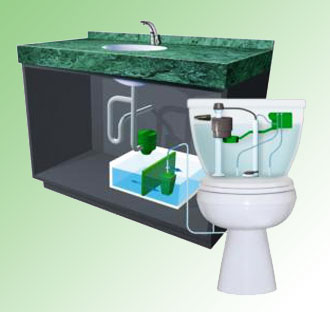Gray water simply means water that has been used previously in the home (except for toilet water) that flows into our drainage systems. This includes the water used for washing dishes, for taking baths and laundry water, among others. Gray water or residential wastewater makes up about 50 to 80% of wastewater all over the world. To counter wasting precious water, various systems have been developed to help recycle gray water.
Gray water may be reused for irrigation or other things, through gray water recycling systems. These systems effectively enables us to reuse sink water, as well as water from dishwashers, washing machines, showers and all non-toilet devices in an average home.
There are generally many types or designs of gray water systems being employed today, which can be broken down into more need-specific systems:
Gravity Gray Water System
Gravity or Manual Gray Water System. As its name suggests, this type of system relies solely on gravity to bring the gray water to the areas that need it, thereby eliminating the need for pumps or electricity. This is a general type of gray water system that can either be filtered or not, depending on use. A basic component of a gravity gray water system is the diverter valve, which can direct the gray water to filters or to disposal areas. A typical gravity gray water system channels water from a source (such as a washing machine) to mulch basins or gardens.
Packaged Gray Water System
Packaged Gray Water Systems. This type of system makes use of electricity or a pump to channel gray water to various areas. Packaged gray water systems use different filtration or disinfection processes to cleanse debris, pathogens and other particles from the water. The water from this system can be stored in a tank until it is needed.
Hybrid gray water systems
Hybrid systems. This is a combination of both the gravity and packaged gray water systems. By using a pump-and-store design combined with pressurized irrigation, this system provides a simple, easy-to-use mechanism that can purge itself on a regular basis and can provide disinfected water for many uses.
These three general systems can be sub-divided into three specific systems based on additional processes involved.
Diversion-only Gray water system
Diversion-only system. This type of system is the easiest and simplest to use since it also only requires little maintenance. It diverts the water via a hose or a pipe and directs it to areas where it is needed through gravity. However, to prevent clogging your land or irrigation areas, you will have to use a mulch basin (a circular pit filled with mulch, usually located around trees or plants) to filter lint and hair.
Diversion and filtration gray water system
Diversion and filtration system. A removable mesh, screen or other filtration devices are installed in this system to trap lint, hair and other particles. These filters have to be cleaned regularly to enable the system to work properly. Some diversion and filtration systems have a surge tank to regulate the flow of water into gardens or irrigation areas to avoid run-off water. State laws have to be checked regarding the installation and regulation of this type of system.

Diversion and treatment gray water system
Diversion and treatment system. This is the most expensive option for reusing household water or gray water. Household waste water is collected in a special tank and then brought or pumped into a deep sand filtration bed, which gets rid of particles like lint, grime and hair. The water is then disinfected by enzymes, bacteria, chlorine or UV light, which destroys pathogens and unwanted chemicals.
Why use gray water systems?
Besides helping the environment, gray water systems have other advantages, including:
- The use of a gray water system helps farmers irrigate plants and crops where the constant flow of water is a problem.
- Using these systems relieves our fresh water sources from the stresses of overuse. Gray water, for instance, maybe reused in irrigation, to flush the toilet or even other tasks such as washing cars. This amounts to a huge leap in water conservation everywhere.
- Recycling gray water can save from 25 to 40% of drinkable water. If gray water recycling is practiced at a community-wide scale, we could reduce the size and number of water-purification and sewage-treatment facilities in our areas.
- The use of gray water systems can reduce your water bill considerably.
- When gray water is reused, we lessen the pollution of our fresh water sources and waterways.